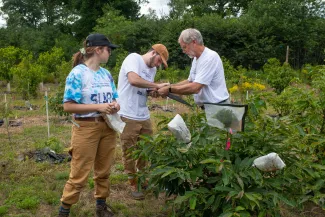
UNE researchers continue their work to save the American chestnut tree using research other scientists have abandoned.
As Virginia May (M.S. Environmental Science, ’25) weeded on her knees on a hot August day in a coastal Maine orchard — a University of New England research site — she looked like any other happy gardener. But, the research May has conducted the past year alongside Tom Klak, Ph.D., a UNE professor in the School of Marine and Environmental Programs, is at the center of a controversy about a genetically modified version of the American chestnut tree.
May’s research flies in the face of a movement in the scientific community to abandon the genetically modified American chestnut tree produced at the State University of New York. But May and Klak have stayed the course in their research — with results that so far prove promising.
On Sept. 13, they’ll present their findings at the annual conference on Chestnut Science in Syracuse, New York.
“As scientists, we don't think we have enough data to firmly take a stance on this,” May said. “I think it’s short-sighted to do so considering we’re working with an organism that has a lifespan that would outlive us fivefold. The transgenic chestnuts that I’m studying are 4- to 5-year-old trees, they’re so young.”
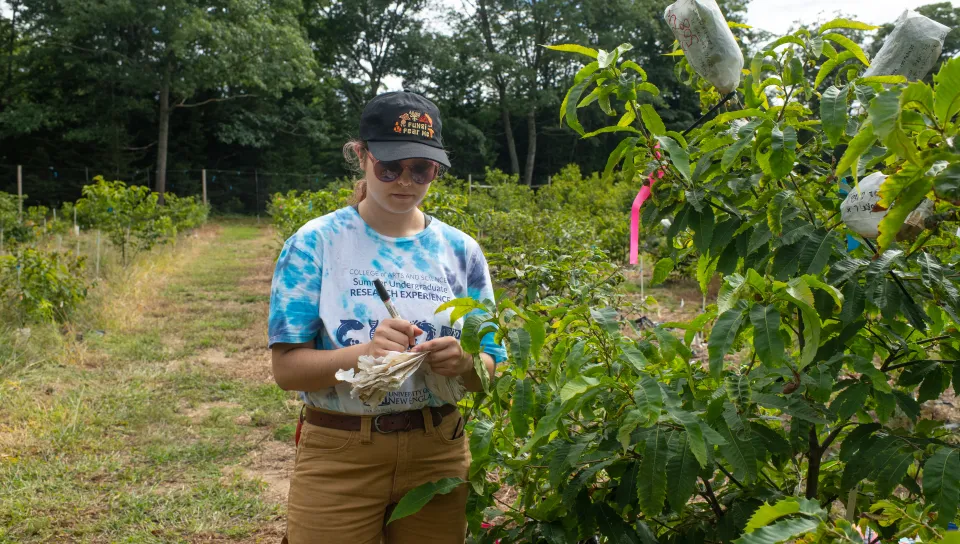
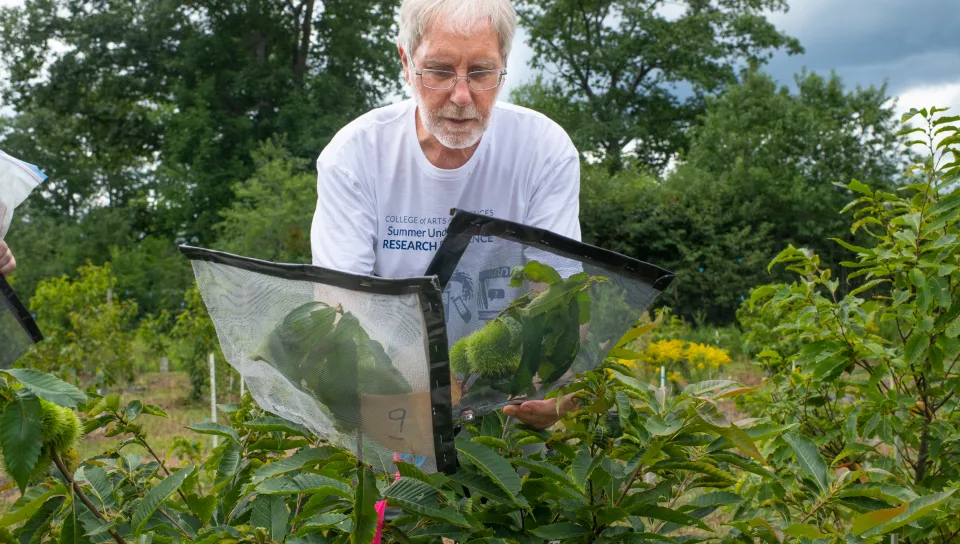
Virginia May (left) and Tom Klak
Last year, a team of researchers at UNE and the University of Maine found that the wheat gene for blight tolerance is located on a different chromosome than what was reported by the SUNY lab. As a result, in December 2023 the American Chestnut Foundation announced it would no longer support SUNY’s College of Environmental Science and Forestry transgenic chestnut strain, called Darling 54.
But Klak and May contend the Darling 54 should not be abandoned until more data are gathered — and it may hold promise in the long-term effort to restore the species, because the wheat gene in the Darling 54 increases blight tolerance.
“The science so far hasn’t told the whole story,” Klak said. “Right now, we’re seeing if this gene is enough to let the trees become mature chestnut trees in nature. These trees are not going to be perfect. But maybe can they be strong enough with the extra gene to be able to handle the fungal blight and survive it. That’s the question we’re addressing right now. Hopefully, it will be enough for them to reproduce. Then let nature take its course over the longer term.”
For decades, scientists have worked to create a blight-tolerant strain of the American chestnut tree after more than 3 billion chestnut trees were wiped out from the blight that was accidentally imported from Asia in the late 19th century.
After nine years of trying to restore the American chestnut, Klak is still at it. He has studied and tested hundreds of different lineages of wild and genetically modified chestnuts, searching for the best genetic combinations. The work is tedious, but Klak believes his research team is making progress.
Over the past five years, Klak refined a new speed-growing technique using grow lights to cut the time needed to raise a chestnut seedling into a mature tree from four or more years to just 12 months. The seedlings are grown in a lab in the Arthur P. Girard Marine Science Center, where they produce transgenic chestnut pollen and seeds. Later many are replanted in a protected, fenced-in section of a private orchard where the trees have been inoculated with the most virulent strain of the fungal blight to test their tolerance.
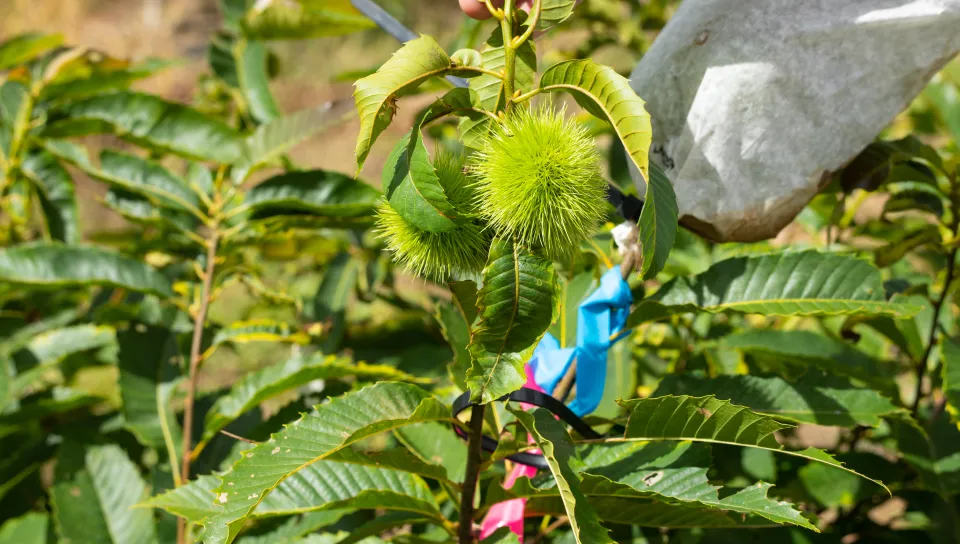
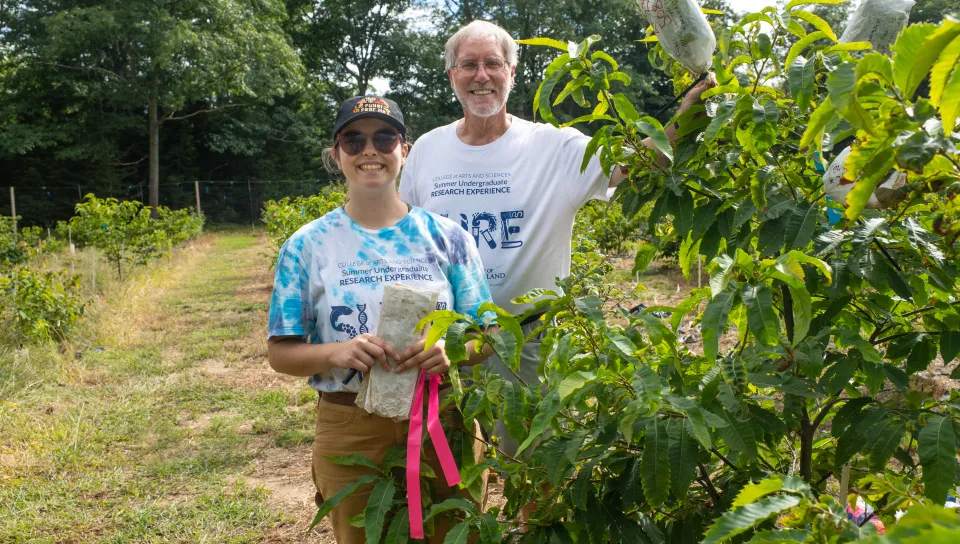
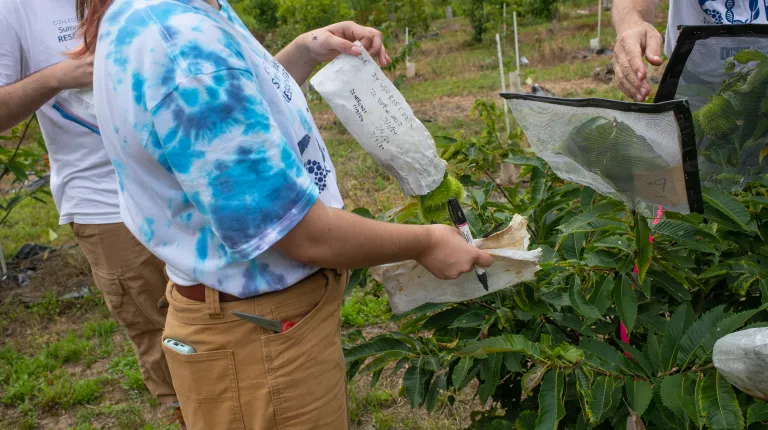

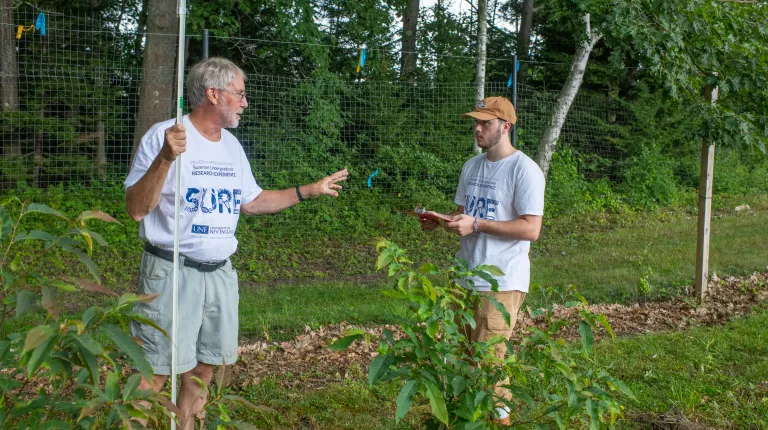
Clockwise, from top left: Maturing Darling 54 seeds are enclosed in burs; May and Klak work in UNE’s experimental orchard; Klak and Environmental Science major Jacob Osmer measure the height of chestnut trees in the experimental orchard; Klak secures a wire bag; and paper bags are swapped out for wire-mesh bags to protect ripening chestnut seeds.
At this family-owned orchard in Cape Elizabeth, Maine, the chestnut trees are carefully planted and, when flowers sprout on the more mature trees, they pollinate them, and the green balls (burs) are enclosed by Klak and May in wire-mesh bags to prevent the seeds from spreading and taking root elsewhere.
“So far, the ones with the gene are statistically better at fighting the fungal blight,” Klak said, adding that they’ll have more data — and answers — this fall. “It’s looking promising. We feel we have good data and good results.”
For her master’s thesis, May is comparing the trees’ defense against the fungal blight across a range of chestnut trees, including Chinese chestnuts, wild-type American chestnuts, and two types of genetically modified trees containing the wheat gene that was inserted in the SUNY lab, called Darling 54s and Darwins.
After inoculating more than 200 trees with the most virulent strain of the fungal blight, May has discovered that, while most trees have shown signs that the blight has taken hold, on average, the trees with the extra gene tolerate the blight better than the wild-type and even the Chinese which have natural immunity. And two of the inoculated Darling 54s have grown flowers — a promising sign suggesting the trees might tolerate the blight, mature, and proliferate.
Klak calls the work to restore the American chestnut tree one of the most important modern-day conservation efforts east of the Mississippi River. The reason: Returning the wild food source the trees once produced would help wildlife thrive in the face of a changing climate as more species migrate north.
May has embraced the mission.
“I have a lot of respect for the trees, and I don't want to discount what they do and what the science shows us,” May said. “As climate change pushes everything northward, Maine’s going to be central in the American chestnut range. So how they grow and how the blight impacts them here is going to be just as important as the southern range, which we also need to help conserve.”